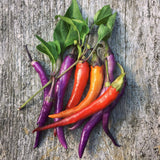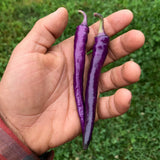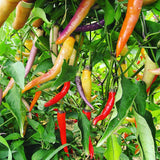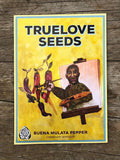Buena Mulata Pepper
Capsicum annuum
Please also check out the African Diaspora Collection Seed Packets and Postcards bundle.
Beautiful, spicy, and flavorful cayenne pepper that starts purple and then passes through salmon and orange on the way to turning a gorgeous red. The tall striking plants are laden with 4-5 inch fruits, which are tasty at all stages, but we prefer the added sweetness of the fully red fruit.
Buena Mulata Pepper was the name on the baby food jar next to the name "Pippin" in the bottom of the deep freezer in William Woys Weaver's grandmother's basement, a decade after his plant-loving grandfather's untimely death. If you've heard of the Fish Pepper, this story probably sounds familiar. There were many other seeds besides those of the beautiful, delicious, and now widely-available Fish Pepper in that frozen trove, and many that passed through Horace Pippin's hands, including this Buena Mulata. Horace Pippin is now a well-known artist who beautifully depicted everyday life, landscapes, religion, WWI, and themes of the injustices of slavery and segregation. In the 1940s, he traded seeds from his friends in the Black catering communities of Philly and Baltimore in exchange for bee sting therapy for WWI arm injury from William Woys Weaver's grandfather H. Ralph Weaver's hives. Seeds stay viable longer in the freezer; our heirlooms only survive if someone removes them from storage and places them in soil; and stories only live when they are told.
Days to maturity: 75-80
Seeds per pack: 25
Germination rate: 91% on 01/28/2025
Planting / harvesting notes
Start seeds indoors 8-10 weeks before the last frost and transplant into garden well after the danger of frost. Keep seedlings moist but do not overwater. Transplants should be initially watered in well, and plants will be most productive with regular irrigation and full sun.
Seed keeping notes
Peppers are generally self-pollinating, though we isolate different varieties of the same species by at least 50 feet, in hopes that flying insects will not cross pollinate them unexpectedly. There are several important species of peppers, so check your scientific names! Pepper seeds are ripe when the fruits have turned their final fiery color - in this case, fully red. Cut the fruit, scrape out seeds, and lay them out to dry on a labeled screen or paper product in a ventilated place away from direct sunlight for a week or two. Drying the peppers before seed extraction can slightly lower your germination rates, but works fine for home seed saving as long as the peppers do not rot.















